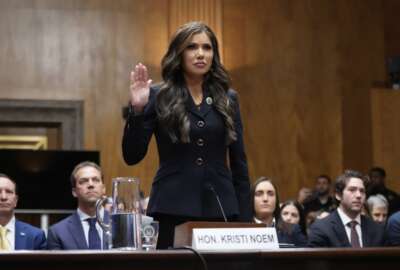DHS improving aim to stop counterfeits at the borders
The Homeland Security Department is taking a two-pronged approach to protecting the federal supply chain. The first addresses the DHS mission cargo crossing into...
wfedstaff | April 17, 2015 3:51 pm
Protecting the federal supply chain doesn’t fall to one agency or even a set of departments. But the Homeland Security Department, over the past 18 months, is out in the lead on several fronts to stem the tide of counterfeit products coming into the country and possibly affecting agencies’ ability to meet their missions.
And the government is now more than ever recognizing the necessity to galvanize its efforts around protecting intellectual property and assuring the safety and quality of software.
“There’s a fundamental shift that’s taking place in how we think about the supply chain and our national security because of dependency that citizens, cities and countries now place on the exchange of goods,” said David Heyman, the DHS under secretary for policy in an exclusive interview with Federal News Radio as part of the multimedia series Inside the World’s Biggest Buyer. “We’ve gone to real time or just in time delivery of goods for medicines, food and technology all around the world. It’s more and more looked at that global supply chains, the delivery systems and the products that are in them need to be secured and resilient against disruptions, but also against exploitation.”
President Barack Obama issued the National Strategy for Global Supply Chain Security in January as part of an effort to protect the nation’s interests. Under the strategy, the administration told agencies to focus on “those components of the worldwide network of transportation, postal and shipping pathways, assets and infrastructures by which goods are moved until they reach an end consumer.”
Two-pronged approach
DHS’s role in securing the supply chain started well before the January strategy release.
Heyman said the agency has been working on a two-pronged approach. The first deals with improving how they target possible suppliers of counterfeit goods.
“Our National Targeting Center looks to do a risk calculation on cargo coming into the United States,” he said. “We look at who the shipper is, how often the person ships and we look at a number of different risk indicators and that provides us a risk score. That capability then allows our customs and border officials to do targeting of high risk products coming to the U.S. based on specific concerns. If it’s counterfeit IT or electronic goods that we are concerned about, they would be categorized.”
Heyman said DHS also is working through the World Customs Organization to standardize how to categorize goods as low, medium or high risk, and how early agencies get information in order to do a risk calculation.
“We need to streamline trusted trader programs, working with the private sector and our partner governments around the world, establishing global guidelines for the security of companies and how they operate within the supply system so we can identify the low-risk shippers in effect and focus on the high-risk concerns,” he said.
Heyman said DHS already is seeing benefits from many of these efforts.
“We are getting in our Air Cargo Advanced Screening Program pre-departure shipper’s data and a number of countries and airlines around the world that shipment data, when reviewed, allows us to do very sophisticated targeting, which we are doing today and the initiative was just started in the last year,” he said.
An interagency effort
The second prong is the Intellectual Property Rights (IPR) Center, which may be led by DHS’s Immigration and Customs Enforcement (ICE), but includes 21 other agencies, such as the FBI and the Postal Service, focusing on important IP issues.
Heyman said the two efforts have helped increase the number of seizures at the border by 20 percent to 24,000 in 2011 as compared to 2010. He said this was the highest number of seizures ever at the border.
He said one recent example that became public in November when someone was trying to bring counterfeit Cisco products over the border.
“The individual had taken fake labels and put legitimate serial numbers on them,” Heyman said. “We were able to identify, investigate and prevent the actions from going forward. It was about a $1 million transaction and that individual was sentenced last November.”
The IPR serves as the communication hub for the law enforcement agencies doing investigations or undercover operations on IP violations.
“Other agencies at the table are able to share information with each other so they are not both investigating each other,” he said. “If you stand up an undercover operation, you don’t want two undercover operators investigating each other. That center is largely to de-conflict those types of investigations or coordinate if you have multiple agencies working together over a single investigation.”
RELATED STORIES:
Obama: Global supply chain security part of national security
Agencies, vendors ramping up to fight supply chain cyber threats
Inside the World’s Biggest Buyer
Copyright © 2025 Federal News Network. All rights reserved. This website is not intended for users located within the European Economic Area.
Jason Miller is executive editor of Federal News Network and directs news coverage on the people, policy and programs of the federal government.
Follow @jmillerWFED






